An overview of major species and production clusters
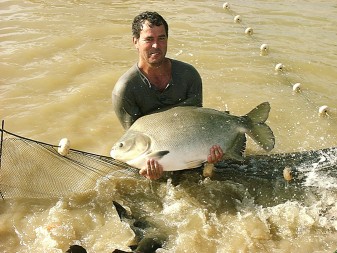
The current economic and political environment in Brazil is challenging. Widespread corruption scandals have led to a downturn in the country’s economy, with a major devaluation of the Brazilian currency, the Real, increasing inflation, unemployment and interest rates. The government was slow to implement necessary changes in its economy in 2015. Major government budget cuts and fewer investments combined for Brazil to lose international credibility and to a downgrade of the country’s degree of investment. All of this placed Brazil under a cloud of uncertainty. Expectations for 2016 and 2017 are no better. Brazilian agribusiness, however, prevented the total collapse of the economy, due to exports like soybeans, corn, poultry and beef.
The aquaculture sector, which was already struggling with the severe droughts in the Northeast and the lower than average rainfall in Southeast Brazil, is also expected to suffer with the economic recession. Prices paid to aquafarmers need to increase to keep up with the increased costs of aquafeeds, energy and other production inputs. However, increases in prices may jeopardize domestic sales, as family budgets are already stressed from unemployment, reduced income and inflation. Export is the alternative for Brazilian aquaculture to grow under this crisis. This article (presented in two parts) brings an update on the current status of the aquaculture sector in Brazil and discusses the limitations and opportunities for the coming years under a recessive economy and following its expected health restoration.
Brazil in numbers
Brazil is the largest country in size, population, and GDP, and therefore the largest market in Latin American (Table 1). Brazil is a major producer of poultry, beef, pork, soybeans, corn, sugar and many other agricultural commodities. Iron mining and crude extraction are other important sources of revenues. Since its 1990’s record of nearly 1 million MT, the capture fisheries have decreased in volume to no more than 600,000 MT today. In the last two decades seafood demand has been met through the expansion of aquaculture, which grew from 31,000 MT in 1994 to estimated 600,000 MT in 2014, as well as by the increased imports of seafood (400,000 MT in 2014).
Aquaculture has experienced its fastest growth in the last decade (averaging 8 percent per year) compared to other animal industries (Figure 1), but it is still far behind the production attained by poultry, beef and pork industries. Brazil has a strong domestic market, copious crops of grains, a well-established animal feed industry, year-round tropical climate in most of the country, abundant fresh water, large areas suitable for ponds, an 8,500-km coastline for marine aquaculture, 4.2 million hectares of inland reservoirs, capable production technology, various universities and research centers dedicated to aquaculture, and conditions that can help boost sustainable aquaculture along with better organization and more effective government policies for the sector.
| CATEGORY | VALUE |
|---|---|
| Estimated population | 204,000,000 |
| GDP 2014 (in trillions of US $) | 2.24 |
| Inflation rate (2014) | 7.7% |
| Country area | 8,515,767 km2 |
| Coastal line extension | 8,500 km |
| Est. area of reservoirs | 42,000 km2 |
| Poultry production (MT/year) | 12,691,000 |
| Beef (MT/year) | 8,200,000 |
| Pork (MT/year) | 3,470,000 |
| Aquaculture (MT/year) | 600,000 |
| Capture fisheries (MT/year) | 500,000 |
| Soybean crop (MT in 2014) | 85,000,000 |
| Corn crop (MT in 2014) | 79,000,000 |
| Animal feed production (MT in 2014) | 67,000,000 |
| Aquafeed production (MT in 2014) | 806,000 |
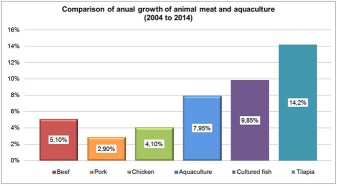
Aquaculture production in Brazil: Major species and production clusters
For political convenience, official government statistics on Brazilian aquaculture were misleading during the last few years. In 2010 ACQUA IMAGEM started a systematic collection of data on production, prices, aquaculture and aquafeed companies and other data related to major aquaculture clusters in Brazil (Figure 2). Data from ACQUA IMAGEM surveys for 2011 and 2014 were published in Panorama da Aquicultura, a Brazilian aquaculture magazine. Acqua Imagem estimated that 486,000 MT of finfish were cultured in Brazil in 2014. The Brazilian Association of Shrimp Farmers (ABCC) recorded that 90,000 MT of marine shrimp were cultured in the same year.
A recent survey by EPAGRI revealed a production of about 18,000 MT of Perna perna mussels in the state of Santa Catarina. In addition to these numbers, a smaller production from other minor aquaculture species (oysters, freshwater shrimp, marine finfish and seaweeds), leading to a total of 600,000 MT of aquaculture products produced in 2014 (Figure 3).
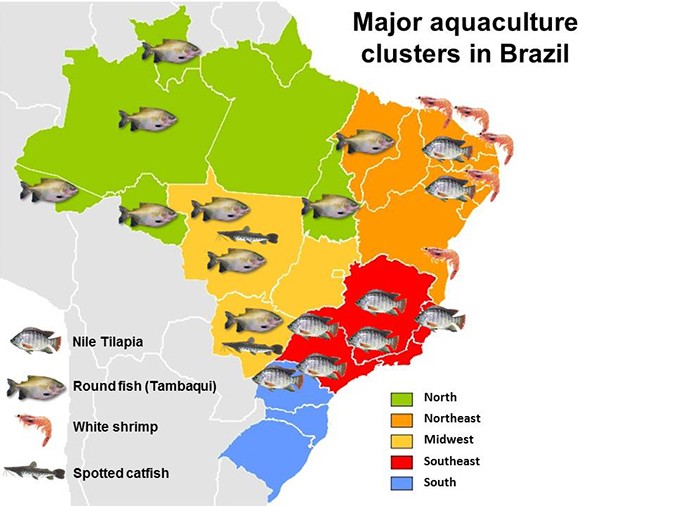
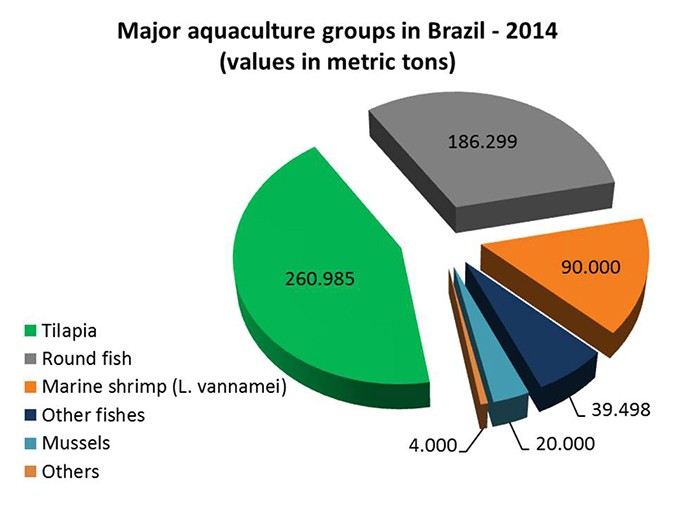
Tilapia
The main aquaculture species in Brazil, with 260,000 MT produced in 2014, 31 percent higher than in 2011, according to ACQUA IMAGEM data. Tilapia production grew at an average of 14.2 percent a year in the last decade. Major tilapia clusters are located in the State of Western Paraná (pond culture) and in the reservoirs of Northeast and Southeast Brazil (cage culture). In Northeast Brazil major tilapia clusters are found along the course of the San Francisco River (Lakes Sobradinho, Itaparica, Moxotó and Xingó) and the Jaguaribe River (Lakes Castanhão and Orós).
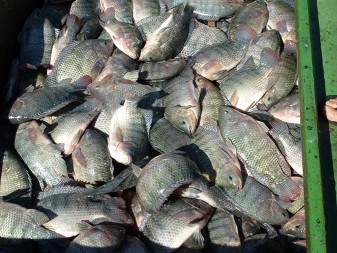
Other Northeastern reservoirs have gone completely dry following three consecutive years of drought, forcing many tilapia producers out of the business or to move to other regions. In Southeast Brazil, tilapia production in cages is mostly concentrated in the lakes along rivers such as the Rio Grande, Paraná, Tietê and Paranapanema, which covers areas of the states of São Paulo, Paraná, Mato Grosso do Sul and Minas Gerais. Low rainfall has also compromised tilapia production in these southeastern lakes.
Round fishes
Species of the genera Colossoma and Piaractus are second in Brazilian aquaculture, with 186,000 MT produced in 2014, a sharp increase in production from the 97,000 MT estimated in 2011. Tambaqui and its hybrids with Pacu (known as “tambacu”) and with Pirapitinga (known as “Tambatinga”) are the main fishes in this group. Culture of round fishes expanded rapidly, particularly in the states of Rondônia and Mato Grosso. These neighboring states produce 50 percent of all round fishes farmed in Brazil. Both states have vast areas for pond aquaculture, year-round tropical climate, and major crops of soybeans and corn, plus the large scale spirit of agribusiness that permeates new aquaculture projects, leading to a quick increase in production. Other important producers are found in the states of Roraima, Tocantins, Maranhão and Amazonas.
Marine shrimp
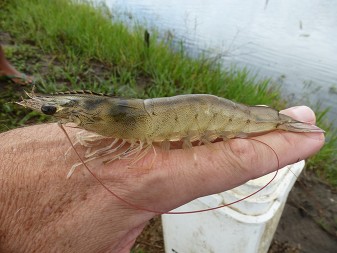
The Pacific white shrimp (Litopenaeus vannamei) is the third most cultured species in Brazil, with 90,000 MT in 2014. Aquaculture of marine shrimp is concentrated in coastal areas of the Northeast, mainly in the States of Ceará, Rio Grande do Norte, Bahia and Piauí. There are also many farmers in the interior regions of Ceará, Rio Grande do Norte and Paraíba, farming shrimp in low salinity water. Over the past 10 years, production of marine shrimp in Brazil was marked by ups and downs (oscillating from 65,000 to 90,000 MT/year) due to trade barriers (export markets), unfavorable exchange rates, disease outbreaks and unexpected floods at major production areas.
Other aquaculture species
These include carps, catfishes, arapaima and rainbow trout, and miscellaneous native species contributed to the total with nearly 40,000 MT in 2014. Culture of mussels in the state of Santa Catarina was estimated at 18,000 MT. Other cultured species were oysters, cobia, Malaysian freshwater prawn (M. rosenbergii) and seaweed, adding 4,000 MT in 2014.
Now that you've reached the end of the article ...
… please consider supporting GSA’s mission to advance responsible seafood practices through education, advocacy and third-party assurances. The Advocate aims to document the evolution of responsible seafood practices and share the expansive knowledge of our vast network of contributors.
By becoming a Global Seafood Alliance member, you’re ensuring that all of the pre-competitive work we do through member benefits, resources and events can continue. Individual membership costs just $50 a year.
Not a GSA member? Join us.
Author
-

Fernando Kubitza, Ph.D.
Acqua Imagem Services in Aquaculture
Rua Evangelina Soares de Camargo, 115
Jardim Estádio – Jundiai/SP – CEP 13203-560 BRAZIL[114,98,46,109,111,99,46,109,101,103,97,109,105,97,117,113,99,97,64,111,100,110,97,110,114,101,102]
Related Posts
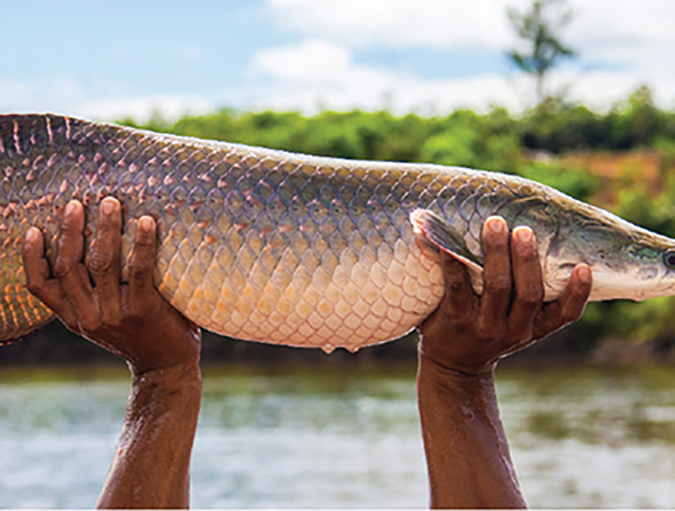
Innovation & Investment
Pirarucu culture in the Brazilian Amazon
With their fast growth and ample light-flavored flesh, pirarucu present great potential. Industry growth is hampered by limited technology and management of domestication practices. Also, current commercial diets are typically not fully suited to the nutritional needs of pirarucu.
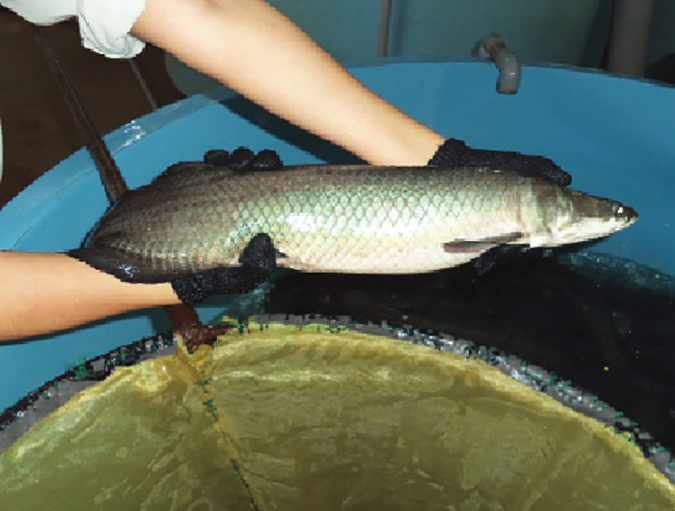
Aquafeeds
Soy-based feeds evaluated for production of Amazonian paiche
A cooperative feeding demonstration conducted by USSEC and Amazon Fish Products S.A. evaluated the use of soy to partially replace fishmeal in diets for paiche, or pirarucu, the largest freshwater fish species.
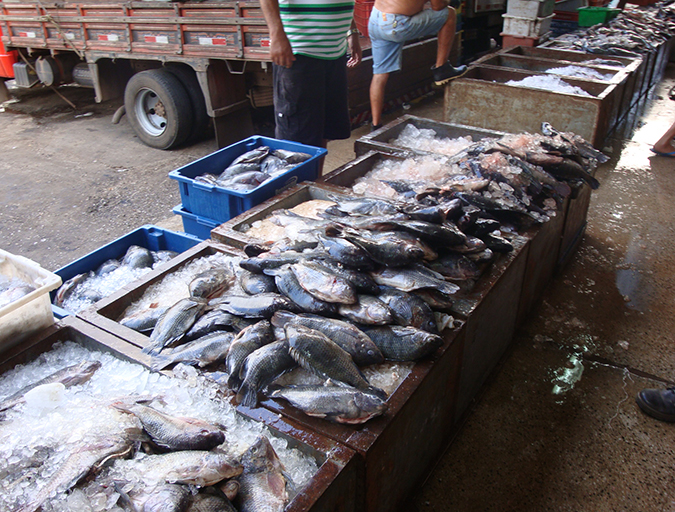
Intelligence
Brazilian aquaculture: Constraints and challenges (Part 2)
Brazil will have to deal with an adverse economic and political environment in the next few years. One should expect high value fish products like shrimp, tilapia, Chilean salmon and cod being replaced by more affordable seafood and alternative meats, as consumers keep losing purchasing power due to inflation, unemployment and monetary devaluation.
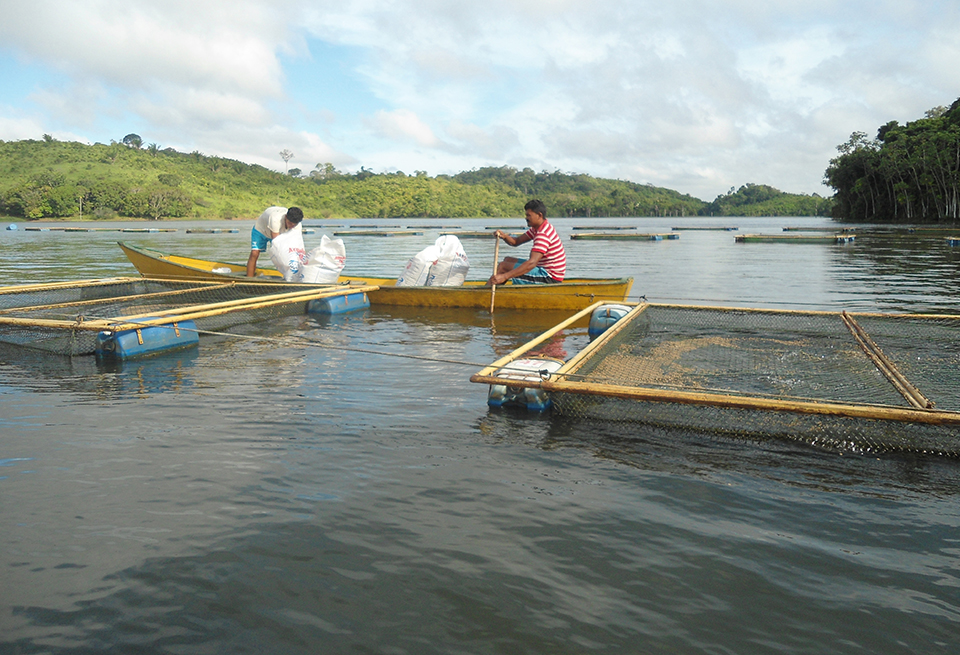
Innovation & Investment
Aquaculture planning, development in Brazilian federal waters
The aquaculture industry in Brazil is moving toward further expansion with the support of the federal government. A key strategy of the More Fishing and Aquaculture plan is the development of aquaculture in federal waters. The plan promotes sustainable development of fisheries and aquaculture by linking those involved and consolidating state policies addressing social inclusion, security and food sovereignty. Tilapia is the main farmed fish, although tambaqui and others have potential for large-scale production due to their wide acceptance by consumers.


